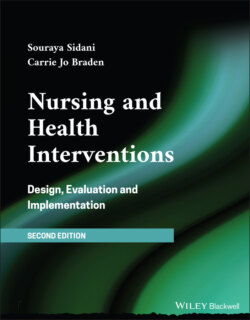Читать книгу Nursing and Health Interventions - Souraya Sidani - Страница 29
2.1.2 Interventions
ОглавлениеThe terms “intervention,” “treatment,” and “therapy” are interchangeable. Although widely used in written (e.g. books, published research reports) and verbal (e.g. case conference, end of shift report in the practice setting) communications, only a few formal definitions of interventions have been located in recent literature (Table 2.1). A thorough examination of these definitions points to two key attributes that define interventions. The first attribute is that interventions are essentially activities. They involve the application of specific techniques by the health professional delivering interventions and the clients receiving interventions. The second attribute is rationality. Rationality means that interventions are given in response to an actual or potential health problem, and directed toward attainment of desired goals. Accordingly, interventions are sets of activities performed by health professionals and clients, independently or collaboratively, to address problems experienced by clients and to achieve beneficial outcomes.
Interventions are more specific than strategies. Strategies provide general principles informing the generation of new or the selection of available evidence‐based techniques. For instance, a behavioral conceptualization of chronic insomnia provided guidance for developing the stimulus control therapy. The stimulus control therapy consists of specific recommendations for sleep behaviors (known to perpetuate insomnia) to do or avoid, and specific techniques to assist clients in carrying out these recommendations. The techniques include providing information on the association between sleep behaviors and insomnia, prompting identification of barriers and possible solutions, and encouraging self‐monitoring of sleep behaviors and parameters. These three specific techniques are described as replicable behavior change techniques designed to alter behaviors (Abraham & Michie, 2008; Carey et al., 2018).
TABLE 2.1 Formal definitions of interventions.
| Field | Definition | Reference |
|---|---|---|
| Nursing | Deliberate cognitive, physical, or verbal activities performed with, or on behalf of, individuals and their families, that are directed toward accomplishing particular therapeutic objectives relative to individuals' health and well‐being | Grove et al. (2015) |
| Actions, treatments, or technologies, that are physical, psychological, social in nature, with predicted outcomes | Forbes (2009) | |
| Public health | Planned actions to prevent or reduce a particular health problem or the determinants of the problem | Wight et al. (2015) |
| An act performed for, with, or on behalf of a person or population with the purpose to assess, improve, promote, or modify health, functioning, or health conditions | Cambon et al. (2019) | |
| Behavior health | Coordinated sets of activities or techniques introduced at a given time and place to change the behavior of individuals, communities, or populations through a hypothesized or known mechanism | Araújo‐Soares et al. (2018) |
| Social/implementation science | Events within systems, aimed to disrupt the functioning of complex systems through changing relationships, displacing entrenched practice, and redistributing and transforming resources | Moore et al. (2019) |
| Attempts to disrupt mechanisms which perpetuate and sustain a problem in a given time and place | Moore and Evans (2017) | |
| Program evaluation | Specific activities undertaken to make a positive difference in outcomes | Mayne (2015) |
